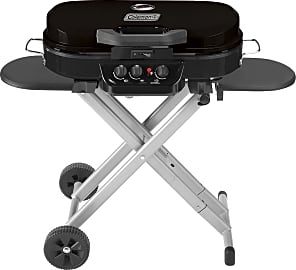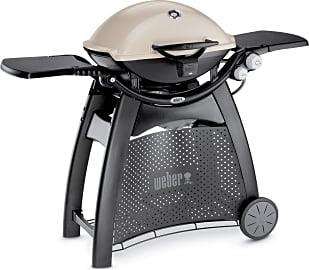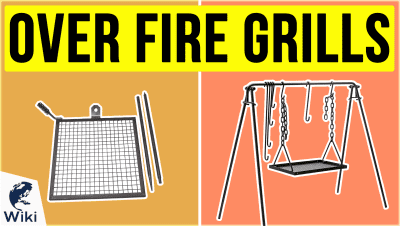The 10 Best Grills

This wiki has been updated 43 times since it was first published in May of 2015. It took a tremendous amount of eating to whittle the world of grills down to the models presented here, but that's just the kind of sacrifice we're willing to make to bring you the best of the best. We've included options for any kind of cookout, ranked here by heat distribution, ease of use and cleanup, cooking area, and durability, so the least you could do is pass the potato salad. When users buy our independently chosen editorial picks, we may earn commissions to help fund the Wiki.
Editor's Notes
April 11, 2019:
Thanks to its designers' ability to pack over 500 square inches of cooking space into such a compact form, as well as offer it to customers in a variety of fun colors, the Weber Spirit II jumped up to the first spot on our list. Elsewhere, availability issues caused us to remove the Char-Broil Big Easy Infrared entirely, replacing it with a charcoal option from Royal Gourmet. Coleman updated their RoadTrip model, making it more convenient and reliable than the previous iteration, which earned it a big upgrade to our second slot.
It's Getting Hot In Here, I Hope
With your basic charcoal grill, the coals themselves radiate upwards of 2,000 degrees Fahrenheit, and all you have to do is get them burning.
Whether direct or indirect, a grill requires radiant heat to cook. That's right: sweet radiation. But rest assured, there's a big difference between char broiled and Chernobyl.
With your basic charcoal grill, the coals themselves radiate upwards of 2,000 degrees Fahrenheit, and all you have to do is get them burning.
When you're working with gas, the flames might reach temperatures around 3,500 degrees, but since so much less radiant heat is given off, that extra heat doesn't do much for the grilling process. Instead, many newer gas grills utilize some kind of intermediary, like lava rocks, ceramic plates, or the "flavor bars" on some Weber models.
These intermediaries absorb the heat of the fire beneath them and radiate it up towards your precious pieces of meat or vegetable. A lot of the time, that intermediary also makes it difficult to see whether or not the fire has actually started, which, if you're careless about your investigation, can lead to some BBQ related catastrophes.
If you're wondering about infrared grills, well these are just a specific kind of gas grill that uses long metal or ceramic grating with extremely tiny holes in it as an intermediary. The amount of space between the fire and this grate, and between the grate and the cooking surface, is drastically diminished to cut down on any dehydrating effects that dry air could have on your food.
The Pyramids Are All Made Of Charcoal
I grew up cooking on gas grills: London broil, grilled sweet onions, grilled pineapple for desert, etc. Those were the best days of the summer. When I got to college, it was all charcoal as far as the eye could see. A man's worth was measured in the speed and alacrity with which he could construct a viable aerated charcoal pyramid and get it burning.
My senior year in college, my housemates and I got a small gas grill that allowed us to more safely conduct 3 a.m. barbecues on the front lawn in the middle of a snowstorm.
There's a certain satisfaction to both ways of cooking. My senior year in college, my housemates and I got a small gas grill that allowed us to more safely conduct 3 a.m. barbecues on the front lawn in the middle of a snowstorm. Honestly, that winter, it was a life saver.
Where you're at in your culinary life and what your cooking needs are shouldn't be too tough for you to determine. If you're cooking for more than two or three people, it's going to save you a tremendous amount of time and energy choosing gas over coal. Getting that large an amount of charcoal to an evenly burn requires a little finesse.
Furthermore, if you're interested in getting a good sauce going along side your meats, one of those side burners could prove indispensable, just be aware that they prevent you from collapsing the side table itself, so the grill's footprint is consistently a little larger.
So, let the number you're regularly cooking for influence your decision, without forgetting your ambitions as a host. After that, consider the space you've got available to you. Beyond that, your decision can be based on bells, whistles, and style.
Come On, Baby, Light My Ancient Fire
Archaeologists and anthropologists place the advent of cooking somewhere in the neighborhood of 300000-40000 B.C.E., as evidenced by carbon dating at a variety of hearth sites unearthed during expeditions.
Even the methods employed in these early hearths resemble the techniques around which modern grills are made.
However long ago it started, we certainly aren't very far removed from it either culturally or socially. Just take one look at a group of men gathered around their grill and tell me they aren't actively channeling their deep ancestry.
Even the methods employed in these early hearths resemble the techniques around which modern grills are made. Those first fires warmed stones that radiated heat more directly than the fire itself could as it slowly became its own pile of useful coals. It's the same stuff they teach kids in Boy Scouts, along with that other ancient activity: helping old ladies cross the street.
Sure the firing mechanisms have made it easier to get the grill started, and features like fuel gauges, thermostats, and extra burners have come to be expected on higher end grills, but the ritual is much the same as it's always been. Remember that each time you flick that easy starter switch and lick those prehistoric chops of yours.















